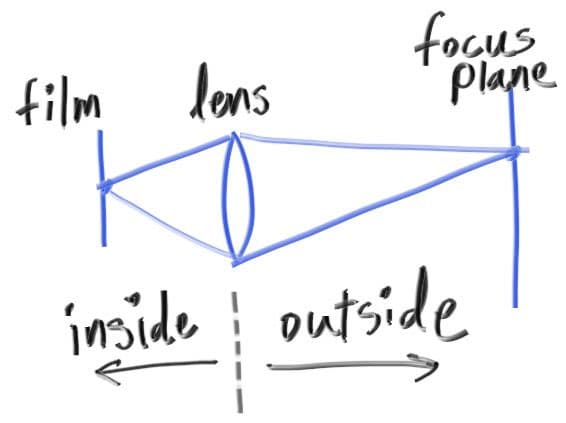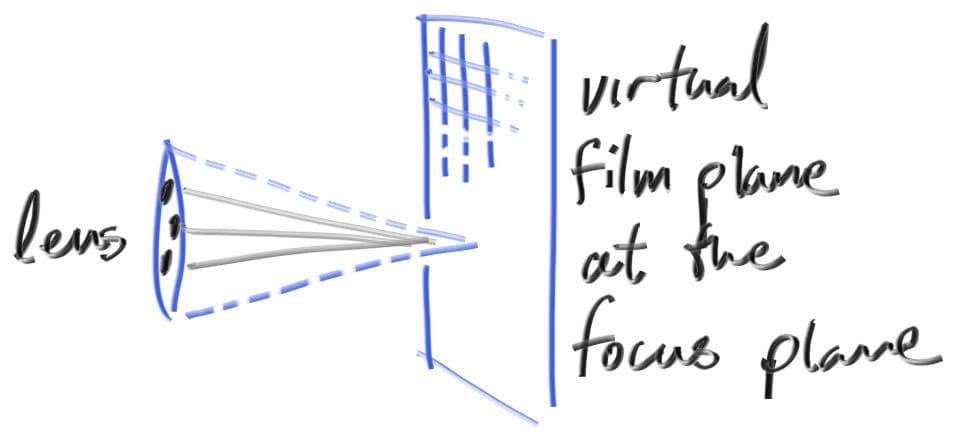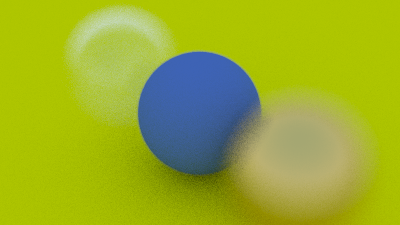Defocus Blur
Now our final feature: defocus blur. Note, all photographers will call it “depth of field” so be aware of only using “defocus blur” among friends.
The reason we defocus blur in real cameras is because they need a big hole (rather than just a pinhole) to gather light. This would defocus everything, but if we stick a lens in the hole, there will be a certain distance where everything is in focus. You can think of a lens this way: all light rays coming from a specific point at the focus distance — and that hit the lens — will be bent back to a single point on the image sensor.
We call the distance between the projection point and the plane where everything is in perfect focus the focus distance. Be aware that the focus distance is not the same as the focal length — the focal length is the distance between the projection point and the image plane.
In a physical camera, the focus distance is controlled by the distance between the lens and the film/sensor. That is why you see the lens move relative to the camera when you change what is in focus (that may happen in your phone camera too, but the sensor moves). The “aperture” is a hole to control how big the lens is effectively. For a real camera, if you need more light you make the aperture bigger, and will get more defocus blur. For our virtual camera, we can have a perfect sensor and never need more light, so we only have an aperture when we want defocus blur.
A Thin Lens Approximation
A real camera has a complicated compound lens. For our code we could simulate the order: sensor, then lens, then aperture. Then we could figure out where to send the rays, and flip the image after it’s computed (the image is projected upside down on the film). Graphics people, however, usually use a thin lens approximation:

We don’t need to simulate any of the inside of the camera. For the purposes of rendering an image outside the camera, that would be unnecessary complexity. Instead, we start rays from the lens, and send them toward the focus plane (focus_dist away from the lens), where everything on that plane is in perfect focus.

Generating Sample Rays
Normally, all scene rays originate from the lookfrom point. In order to accomplish defocus blur, generate random scene rays originating from inside a disk centered at the lookfrom point. The larger the radius, the greater the defocus blur. You can think of our original camera as having a defocus disk of radius zero (no blur at all), so all rays originated at the disk center (lookfrom).
use std::fmt::{Display, Formatter, Result};
use std::ops::{Add, AddAssign, Div, DivAssign, Mul, MulAssign, Neg, Sub};
use crate::common;
#[derive(Copy, Clone, Default)]
pub struct Vec3 {
e: [f64; 3],
}
impl Vec3 {
pub fn new(x: f64, y: f64, z: f64) -> Vec3 {
Vec3 { e: [x, y, z] }
}
pub fn random() -> Vec3 {
Vec3::new(
common::random_double(),
common::random_double(),
common::random_double(),
)
}
pub fn random_range(min: f64, max: f64) -> Vec3 {
Vec3::new(
common::random_double_range(min, max),
common::random_double_range(min, max),
common::random_double_range(min, max),
)
}
pub fn x(&self) -> f64 {
self.e[0]
}
pub fn y(&self) -> f64 {
self.e[1]
}
pub fn z(&self) -> f64 {
self.e[2]
}
pub fn length(&self) -> f64 {
f64::sqrt(self.length_squared())
}
pub fn length_squared(&self) -> f64 {
self.e[0] * self.e[0] + self.e[1] * self.e[1] + self.e[2] * self.e[2]
}
pub fn near_zero(&self) -> bool {
const EPS: f64 = 1.0e-8;
// Return true if the vector is close to zero in all dimensions
self.e[0].abs() < EPS && self.e[1].abs() < EPS && self.e[2].abs() < EPS
}
}
// Type alias
pub type Point3 = Vec3;
// Output formatting
impl Display for Vec3 {
fn fmt(&self, f: &mut Formatter) -> Result {
write!(f, "{} {} {}", self.e[0], self.e[1], self.e[2])
}
}
// -Vec3
impl Neg for Vec3 {
type Output = Vec3;
fn neg(self) -> Vec3 {
Vec3::new(-self.x(), -self.y(), -self.z())
}
}
// Vec3 += Vec3
impl AddAssign for Vec3 {
fn add_assign(&mut self, v: Vec3) {
*self = *self + v;
}
}
// Vec3 *= f64
impl MulAssign<f64> for Vec3 {
fn mul_assign(&mut self, t: f64) {
*self = *self * t;
}
}
// Vec3 /= f64
impl DivAssign<f64> for Vec3 {
fn div_assign(&mut self, t: f64) {
*self = *self / t;
}
}
// Vec3 + Vec3
impl Add for Vec3 {
type Output = Vec3;
fn add(self, v: Vec3) -> Vec3 {
Vec3::new(self.x() + v.x(), self.y() + v.y(), self.z() + v.z())
}
}
// Vec3 - Vec3
impl Sub for Vec3 {
type Output = Vec3;
fn sub(self, v: Vec3) -> Vec3 {
Vec3::new(self.x() - v.x(), self.y() - v.y(), self.z() - v.z())
}
}
// Vec3 * Vec3
impl Mul for Vec3 {
type Output = Vec3;
fn mul(self, v: Vec3) -> Vec3 {
Vec3::new(self.x() * v.x(), self.y() * v.y(), self.z() * v.z())
}
}
// f64 * Vec3
impl Mul<Vec3> for f64 {
type Output = Vec3;
fn mul(self, v: Vec3) -> Vec3 {
Vec3::new(self * v.x(), self * v.y(), self * v.z())
}
}
// Vec3 * f64
impl Mul<f64> for Vec3 {
type Output = Vec3;
fn mul(self, t: f64) -> Vec3 {
Vec3::new(self.x() * t, self.y() * t, self.z() * t)
}
}
// Vec3 / f64
impl Div<f64> for Vec3 {
type Output = Vec3;
fn div(self, t: f64) -> Vec3 {
Vec3::new(self.x() / t, self.y() / t, self.z() / t)
}
}
pub fn dot(u: Vec3, v: Vec3) -> f64 {
u.e[0] * v.e[0] + u.e[1] * v.e[1] + u.e[2] * v.e[2]
}
pub fn cross(u: Vec3, v: Vec3) -> Vec3 {
Vec3::new(
u.e[1] * v.e[2] - u.e[2] * v.e[1],
u.e[2] * v.e[0] - u.e[0] * v.e[2],
u.e[0] * v.e[1] - u.e[1] * v.e[0],
)
}
pub fn unit_vector(v: Vec3) -> Vec3 {
v / v.length()
}
pub fn random_in_unit_sphere() -> Vec3 {
loop {
let p = Vec3::random_range(-1.0, 1.0);
if p.length_squared() >= 1.0 {
continue;
}
return p;
}
}
pub fn random_unit_vector() -> Vec3 {
unit_vector(random_in_unit_sphere())
}
pub fn random_in_unit_disk() -> Vec3 {
loop {
let p = Vec3::new(
common::random_double_range(-1.0, 1.0),
common::random_double_range(-1.0, 1.0),
0.0,
);
if p.length_squared() >= 1.0 {
continue;
}
return p;
}
}
pub fn reflect(v: Vec3, n: Vec3) -> Vec3 {
v - 2.0 * dot(v, n) * n
}
pub fn refract(uv: Vec3, n: Vec3, etai_over_etat: f64) -> Vec3 {
let cos_theta = f64::min(dot(-uv, n), 1.0);
let r_out_perp = etai_over_etat * (uv + cos_theta * n);
let r_out_parallel = -f64::sqrt(f64::abs(1.0 - r_out_perp.length_squared())) * n;
r_out_perp + r_out_parallel
}use crate::common;
use crate::ray::Ray;
use crate::vec3::{self, Point3, Vec3};
pub struct Camera {
origin: Point3,
lower_left_corner: Point3,
horizontal: Vec3,
vertical: Vec3,
u: Vec3,
v: Vec3,
lens_radius: f64,
}
impl Camera {
pub fn new(
lookfrom: Point3,
lookat: Point3,
vup: Vec3,
vfov: f64, // Vertical field-of-view in degrees
aspect_ratio: f64,
aperture: f64,
focus_dist: f64,
) -> Camera {
let theta = common::degrees_to_radians(vfov);
let h = f64::tan(theta / 2.0);
let viewport_height = 2.0 * h;
let viewport_width = aspect_ratio * viewport_height;
let w = vec3::unit_vector(lookfrom - lookat);
let u = vec3::unit_vector(vec3::cross(vup, w));
let v = vec3::cross(w, u);
let origin = lookfrom;
let horizontal = focus_dist * viewport_width * u;
let vertical = focus_dist * viewport_height * v;
let lower_left_corner = origin - horizontal / 2.0 - vertical / 2.0 - focus_dist * w;
let lens_radius = aperture / 2.0;
Camera {
origin,
lower_left_corner,
horizontal,
vertical,
u,
v,
lens_radius,
}
}
pub fn get_ray(&self, s: f64, t: f64) -> Ray {
let rd = self.lens_radius * vec3::random_in_unit_disk();
let offset = self.u * rd.x() + self.v * rd.y();
Ray::new(
self.origin + offset,
self.lower_left_corner + s * self.horizontal + t * self.vertical - self.origin - offset,
)
}
}Using a big aperture:
mod camera;
mod color;
mod common;
mod hittable;
mod hittable_list;
mod material;
mod ray;
mod sphere;
mod vec3;
use std::io;
use std::rc::Rc;
use camera::Camera;
use color::Color;
use hittable::{HitRecord, Hittable};
use hittable_list::HittableList;
use material::{Dielectric, Lambertian, Metal};
use ray::Ray;
use sphere::Sphere;
use vec3::Point3;
fn ray_color(r: &Ray, world: &dyn Hittable, depth: i32) -> Color {
// If we've exceeded the ray bounce limit, no more light is gathered
if depth <= 0 {
return Color::new(0.0, 0.0, 0.0);
}
let mut rec = HitRecord::new();
if world.hit(r, 0.001, common::INFINITY, &mut rec) {
let mut attenuation = Color::default();
let mut scattered = Ray::default();
if rec
.mat
.as_ref()
.unwrap()
.scatter(r, &rec, &mut attenuation, &mut scattered)
{
return attenuation * ray_color(&scattered, world, depth - 1);
}
return Color::new(0.0, 0.0, 0.0);
}
let unit_direction = vec3::unit_vector(r.direction());
let t = 0.5 * (unit_direction.y() + 1.0);
(1.0 - t) * Color::new(1.0, 1.0, 1.0) + t * Color::new(0.5, 0.7, 1.0)
}
fn main() {
// Image
const ASPECT_RATIO: f64 = 16.0 / 9.0;
const IMAGE_WIDTH: i32 = 400;
const IMAGE_HEIGHT: i32 = (IMAGE_WIDTH as f64 / ASPECT_RATIO) as i32;
const SAMPLES_PER_PIXEL: i32 = 100;
const MAX_DEPTH: i32 = 50;
// World
let mut world = HittableList::new();
let material_ground = Rc::new(Lambertian::new(Color::new(0.8, 0.8, 0.0)));
let material_center = Rc::new(Lambertian::new(Color::new(0.1, 0.2, 0.5)));
let material_left = Rc::new(Dielectric::new(1.5));
let material_right = Rc::new(Metal::new(Color::new(0.8, 0.6, 0.2), 0.0));
world.add(Box::new(Sphere::new(
Point3::new(0.0, -100.5, -1.0),
100.0,
material_ground,
)));
world.add(Box::new(Sphere::new(
Point3::new(0.0, 0.0, -1.0),
0.5,
material_center,
)));
world.add(Box::new(Sphere::new(
Point3::new(-1.0, 0.0, -1.0),
0.5,
material_left.clone(),
)));
world.add(Box::new(Sphere::new(
Point3::new(-1.0, 0.0, -1.0),
-0.45,
material_left,
)));
world.add(Box::new(Sphere::new(
Point3::new(1.0, 0.0, -1.0),
0.5,
material_right,
)));
// Camera
let lookfrom = Point3::new(3.0, 3.0, 2.0);
let lookat = Point3::new(0.0, 0.0, -1.0);
let vup = Point3::new(0.0, 1.0, 0.0);
let dist_to_focus = (lookfrom - lookat).length();
let aperture = 2.0;
let cam = Camera::new(
lookfrom,
lookat,
vup,
20.0,
ASPECT_RATIO,
aperture,
dist_to_focus,
);
// Render
print!("P3\n{} {}\n255\n", IMAGE_WIDTH, IMAGE_HEIGHT);
for j in (0..IMAGE_HEIGHT).rev() {
eprint!("\rScanlines remaining: {} ", j);
for i in 0..IMAGE_WIDTH {
let mut pixel_color = Color::new(0.0, 0.0, 0.0);
for _ in 0..SAMPLES_PER_PIXEL {
let u = (i as f64 + common::random_double()) / (IMAGE_WIDTH - 1) as f64;
let v = (j as f64 + common::random_double()) / (IMAGE_HEIGHT - 1) as f64;
let r = cam.get_ray(u, v);
pixel_color += ray_color(&r, &world, MAX_DEPTH);
}
color::write_color(&mut io::stdout(), pixel_color, SAMPLES_PER_PIXEL);
}
}
eprint!("\nDone.\n");
}We get:
